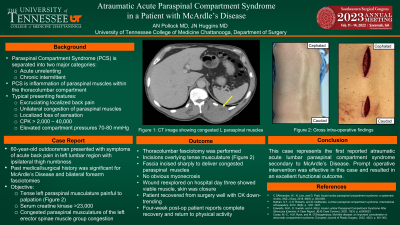General Surgery
Category: Quickshot Oral Session 07
Quickshot Oral : Quickshot Oral Session 07
ATRAUMATIC ACUTE PARASPINAL COMPARTMENT SYNDROME IN A PATIENT WITH MCARDLES DISEASE
Saturday, February 11, 2023
3:00pm - 4:00pm East Coast USA Time


Aaron Pollock, MD
PGY3
University of Tennessee College of Medicine Chattanooga, Department of Surgery, United States- KH
Kevin Harrell, MD
United States
Presenter(s)
Principal Contact(s)
Objectives: Atraumatic acute lumbar compartment syndrome is a subtype of lumbar compartment syndrome thought to be caused by repetitive muscle use during exercise. Increased blood flow and fluid accumulation exceeding the capillary perfusion pressure within the lumbar compartment leads to irreversible ischemic myo- and neuronecrosis. These injuries present as ipsilateral myalgia and paresthesia after activities with sustained muscle use such as weightlifting, snowboarding, or surfing. No established risk factors predict development of atraumatic acute lumbar compartment syndrome and only anecdotal evidence exists to guide clinical decision making. Here we describe a case of atraumatic acute lumbar compartment syndrome with a favorable operative outcome.
Methods: A 60-year-old male presented to the emergency room with complaints of back pain that developed after yard work earlier in the day. He described pain overlying the left lumbar area and loss of sensation overlying the ipsilateral thigh. His left erector spinae musculature was rigid, tense, and painful to the touch, with leioderma overlying the muscles. An elevated serum creatine kinase was identified, and a computed tomography showed evidence of left paraspinal musculature congestion as compared to the right. Past medical history was significant for McArdle’s Disease and bilateral forearm fasciotomies. The patient also has two brothers with McArdle’s Disease dependent on hemodialysis. Given the patients history, clinical presentation, and risk for developing severe rhabdomyolysis, the patient was offered surgical decompression of his lumbosacral fascia.
Results: The patient underwent lumbosacral fasciotomy in February 2022. We had immediate delivery of congested musculature after an incision was made in the lumbosacral facia, with no obvious myonecrosis, and a temporary wound vac was placed. The patient returned to the operating room for skin closure on post operative day two. On post operative day three the patient was discharged home and has since been seen in clinic with no residual pain or change in baseline functional status.
Conclusion: This case may represent the first reported atraumatic exertional lumbar compartment syndrome in a patient with McArdle Disease. Prompt operative intervention was effective in this case and resulted in an excellent functional outcome. Operative intervention should be considered in patients presenting with acute atraumatic paraspinal compartment syndrome. Although further study is needed to examine this rare entity.
Methods: A 60-year-old male presented to the emergency room with complaints of back pain that developed after yard work earlier in the day. He described pain overlying the left lumbar area and loss of sensation overlying the ipsilateral thigh. His left erector spinae musculature was rigid, tense, and painful to the touch, with leioderma overlying the muscles. An elevated serum creatine kinase was identified, and a computed tomography showed evidence of left paraspinal musculature congestion as compared to the right. Past medical history was significant for McArdle’s Disease and bilateral forearm fasciotomies. The patient also has two brothers with McArdle’s Disease dependent on hemodialysis. Given the patients history, clinical presentation, and risk for developing severe rhabdomyolysis, the patient was offered surgical decompression of his lumbosacral fascia.
Results: The patient underwent lumbosacral fasciotomy in February 2022. We had immediate delivery of congested musculature after an incision was made in the lumbosacral facia, with no obvious myonecrosis, and a temporary wound vac was placed. The patient returned to the operating room for skin closure on post operative day two. On post operative day three the patient was discharged home and has since been seen in clinic with no residual pain or change in baseline functional status.
Conclusion: This case may represent the first reported atraumatic exertional lumbar compartment syndrome in a patient with McArdle Disease. Prompt operative intervention was effective in this case and resulted in an excellent functional outcome. Operative intervention should be considered in patients presenting with acute atraumatic paraspinal compartment syndrome. Although further study is needed to examine this rare entity.

